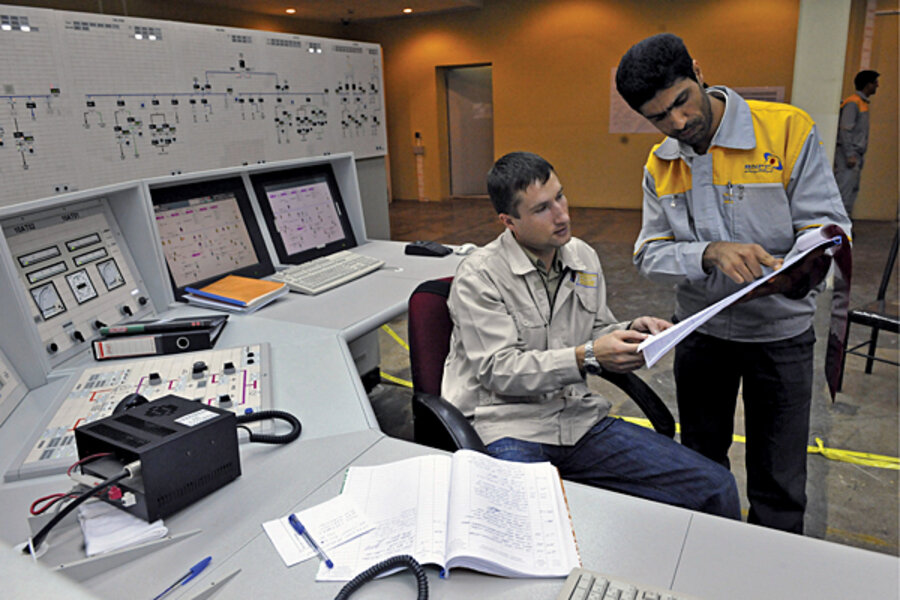Two to tango: Why Iran turns dance partners into enemies
Loading...
| Istanbul, Turkey
On the diplomatic balance sheet, Iran and Russia should be best friends.
Russia is building Iran's first nuclear power reactor – a $1 billion project. It signed a contract to provide S-300 air defense missiles to Tehran. And as Iran's diplomatic isolation enters its fourth decade, Moscow stands out as a past defender of the Islamic Republic that can veto sanctions.
And yet, Iran-Russian relations have soured, with Russia now likely to support new United Nations sanctions against Iran – the latest in a string of examples of Tehran turning potential allies into enemies since the 1979 Islamic revolution.
IN PICTURES: Iran's Islamic Revolution
"As they say, 'It takes two to tango,' and in the case of Iran, it has shown again and again that it doesn't know how to dance," says Mehrzad Boroujerdi, an Iran specialist at Syracuse University, who sums up the past 30 years of Iranian diplomacy as "statecraft by trial and error."
The result in key cases has been turning off, angering, or provoking potential friends from the slim list of countries that have sought to engage Tehran. While the specifics have varied from Canada to Britain and now Russia, the pattern is familiar. To divert the attention of critics at home – a task that became nearly impossible in the wake of the disputed June 2009 election – the revolutionary state has sought to direct that anger outward.
"Revolutions need an outside enemy as a way of consolidating the power of the new regime, forcing people to rally around the flag," says Professor Boroujerdi. "Whenever the state has failed – be it [due to] managerial ineptitude or flip-flopping on declared positions – the government uses the notion of an outside enemy."
Kremlin's rocky history in Persia
With Russia, trust has always been in short supply. The Kremlin's rocky imperial history in Persia stretches back centuries, and includes occupation with British and US forces during World War II.
But it was still a surprise when President Ahmadinejad this month gave all Russian pilots working for Iranian commercial airlines two months' notice to leave Iran after a Russian-made plane with a Russian crew caught fire on landing in January.
Further, Iranian officials have openly criticized Russia's delay in sending the S-300 missiles, a deal done in 1995, and multi-year delays in completing the Bushehr reactor.
Iran has also ordered a commission to investigate the consequences of the Soviet occupation during World War II, raising hackles in a nation sensitive to its role in the Allied victory. All this, topped off by Iran's defiant statements on its nuclear program and February moves to boost uranium enrichment levels, has helped prompt a change of thinking in Russia.
"This is quite a long list," says Alexander Pikayev, a nonproliferation expert at the Center for International Security in Moscow, adding what he believes is Iran's rationale. "First [the Iranians] want to punish the Russians for their support of sanctions. Second, they believe they are very strong now and probably don't need any outside support."
US hopes for engagement dimming
President Obama's efforts to reach out to the Iranian regime are another diplomatic casualty, in which Iran's leaders "probably miscalculated in terms of improving US-Iranian relations under the Obama administration," says Mr. Pikayev.
Supreme religious leader Ayatollah Seyyed Ali Khamenei responded to Mr. Obama's overtures with a litany of historical grievances of US wrongs against Iran, starting with the CIA-orchestrated coup in 1953. Analysts said it was a necessary first response after decades of making "Death to America" a pillar of regime ideology, and did not exclude future talks.
But after Mr. Ahmadinejad's contested reelection and the crackdown that followed, hopes for US engagement have dimmed.
Britain, Canada also turned away
Other episodes include Britain's wooing of Tehran during reformist President Mohammad Khatami's rule, which was going well until London chose its new ambassador – a veteran diplomat who spoke Persian and was married to an Iranian.
Though not Jewish, he was denounced as a "Zionist spy" and rejected.
Canada also had very friendly diplomatic relations with Iran until Iranian-Canadian freelance photographer Zahra Kazemi died in Iranian custody in 2003. While Iranian authorities blamed a stroke, physicians said she was tortured.
"A case like Zahra Kazemi doesn't come about because the government wants to damage relations with Canada, but because the dynamics of domestic politics take over, and then foreign relations with a state like Canada become the victim," says Boroujerdi.
"As far as the Iranian elites are concerned, they look at it through the prism of how their actions are going to consolidate their power domestically," he adds. "Over the last three decades [to roughly 1997], we have seen the assassination of over 100 Iranian dissidents, much of it in Europe [where] every single one ... has caused diplomatic turmoil of some sort.
"But the thinking is that this will blow over, and after a while the need for oil and markets will swing the pendulum again to their favor."





